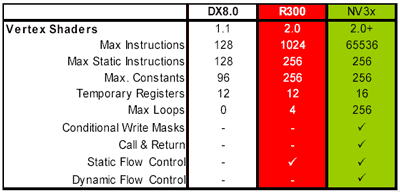NVIDIA Introduces GeForce FX (NV30)
by Anand Lal Shimpi on November 18, 2002 10:13 AM EST- Posted in
- GPUs
An AGP 8X Feed
The first feature of the GeForce FX that we won't spend much time talking about is AGP 8X support. As you all know by now, the initial vertex data is sent by the CPU over the AGP bus to the GPU in order to kick off the rendering process.
In theory, a faster AGP bus with more bandwidth means that more vertex data can get to the GPU and thus speed up the rendering process. In reality however, we aren't coming close to saturating the AGP bus and AGP 8X barely offers a performance improvement over AGP 4X.
NVDIA claims that sending multiple HDTV streams to the GPU is one potential application for AGP 8X's 2.1GB/s of bandwidth, but for now there's no real reason to get excited here.
Massively Parallel Vertex Shader Engine
Since most of the logic behind the vertex shader engine had to be re-written in order to accommodate the needs of DirectX 9, NVIDIA redesigned the vast majority of the GeForce FX's vertex shader engine from scratch. Whereas the GeForce4 had two parallel vertex shader units, the GeForce FX has a single vertex shader pipeline that has a massively parallel array of floating point processors (somewhat similar to 3DLabs' P10 VPU, although we don't have an idea of how many individual processors are at work in parallel).
The parallel FP vertex processors have their own multithreaded instruction set and are obviously optimized for maximum triangle throughput. NVIDIA claims 375 million triangles per second can be passed through the GeForce FX's vertex shader engine, putting it slightly above that of the Radeon 9700 Pro but also keep in mind that we're dealing with a noticeably higher clocked GPU.
Along with this massively parallel vertex shader engine, NVIDIA has also introduced support for DirectX 9's Vertex Shader 2.0 spec. In fact, NVIDIA has in many ways exceeded the DX9 VS2.0 specification. The GeForce FX is able to execute vertex shader programs with more instructions, use more constants and have more loops than conventional VS2.0 architectures (e.g. Radeon 9700 Pro). There are also slightly more registers on the chip itself in order to accommodate some of these increases.

Obviously all of the features of the DX9 VS2.0 specification are support by the GeForce FX, and we've already highlighted some of the important ones here.
What you will quickly notice with the GeForce FX is that a lot of its advantages in pixel and vertex shader support will not be seen in games for at least another year, but more realistically 2+ years down the road. Remember that even Doom3 is built around more of a DX8 platform, with titles that would take advantage of these complex shader programs coming much later than next year. So on paper the GeForce FX will exert a number of these sorts of advantages over the Radeon 9700 Pro, but in the end they will not contribute to the overall performance of the card in the immediate future.










0 Comments
View All Comments